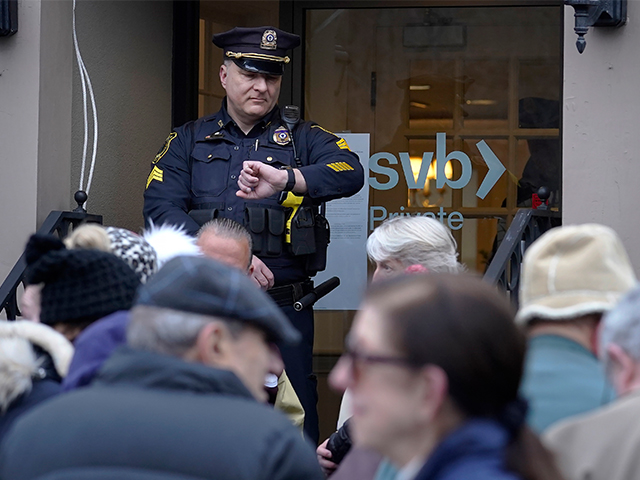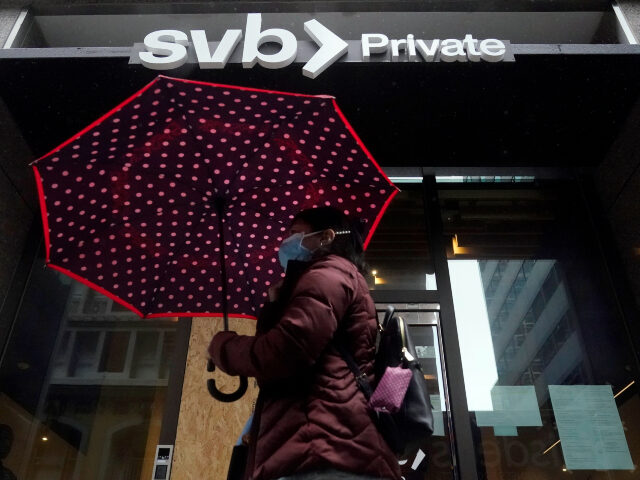Following the collapse of Silicon Valley Bank, reviews of the company’s internal practices have revealed that loans to insiders tripled to $219 million before the bank failed.
Bloomberg reports that last month, Silicon Valley Bank failed as a result of a $42 billion bank run from investors and depositors. The bank’s internal problems have come to light due to the collapse, and regulators are starting to look closely at the bank’s operations before its demise.

A Wellesley, Mass., police officer glances at his watch as customers and bystanders form a line outside a Silicon Valley Bank branch location, Monday, March 13, 2023, while waiting for the branch to open, in Wellesley, Mass. (AP Photo/Steven Senne)
The bank’s lending practices toward insiders, such as its own officers, directors, and principal shareholders, are one area that has received attention. According to government data, loans to insiders more than tripled from the third quarter of 2022 to $219 million in the last three months of the year. Since at least two decades ago, this amount represents a record dollar amount of loans given to insiders.
While there are no allegations of wrongdoing in connection with the insider loans, the Federal Reserve and Congress’ investigation into Silicon Valley Bank’s collapse, the biggest U.S. bank failure in more than a decade, may bring attention to the surge in lending to high-ranking individuals. On March 10, the bank was taken over by authorities, and SVB Financial Group, the bank’s parent company, declared bankruptcy.
Banks are only permitted to lend to insiders if they are given terms similar to those offered to other customers, per federal regulations intended to prevent banking executives from receiving preferential treatment. Regulators mandate that banks make information about the number and value of such loans public in order to aid in conflict prevention. SVB Financial Group said it made loans to related parties last year, including “companies in which certain of our directors or their affiliated venture funds are beneficial owners of 10% or more of the equity securities of such companies.”
According to the filing, the bank issued the loans regularly with comparable interest rates and security as other customers received. In contrast to loans made to insiders, loans in other categories like real estate and commercial loans grew much more slowly.
Loans to insiders increased sharply as the bank’s flaws came to light. According to Fed examiners who discovered the issue late last year, the bank needed to improve how it tracked interest-rate risks. At year’s end, the company had about $15 billion in unrealized losses on mortgage-backed securities that it had purchased when interest rates were lower.
Additionally, the bank shifted its lending strategy to target bigger borrowers, such as venture capital and private equity clients. SVB Financial Group’s annual report for 2022 revealed that loans to clients who received at least $20 million made up about 63 percent of the company’s lending portfolio.
“Our loan portfolio has a credit profile different from that of most other banking companies,” the company said in the report. The firm added that “a significant portion of our loan portfolio is comprised of larger loans, which could increase the impact on us of any single borrower default.”
Despite the rise in loans to insiders, no wrongdoing in relation to the loans has been claimed. The loans, however, might come under scrutiny as regulators look into the bank’s failure.
According to a Federal Reserve spokesperson, if it discovers issues with these loans, the agency will take enforcement action or refers violations to other regulators.
The tech sector, which had relied on the bank to finance startups and emerging technology companies, has been massively disrupted by the collapse of Silicon Valley Bank. Many startups are finding it difficult to find alternative funding sources due to the bank’s failure as other lenders may be more risk-averse now.
The bank’s failure has also prompted concerns about the stability of the U.S. banking system, which has recently seen a surge in the number of new lenders, many of which are targeted at the tech sector.
Read more at Bloomberg here.
Lucas Nolan is a reporter for Breitbart News covering issues of free speech and online censorship. Follow him on Twitter @LucasNolan

COMMENTS
Please let us know if you're having issues with commenting.